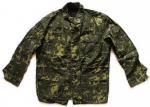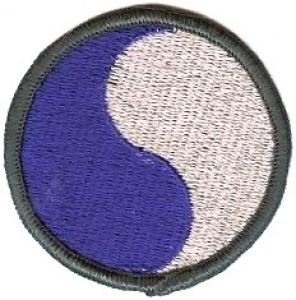Всемирная военная энциклопедия
> США
> Нашивки
> Нарукавные нашивки Сухопутных войск
> Пехота
> US-INPTUS-00022

Нарукавный знак 29 пехотной дивизии СВ США
Случайные:

Кокарда офицера флота на период короля Георга VI ( до 1952г.).

Костюм камуфлированный Вооруженных Сил Украины #3

Эмблема Государственной Пограничной службы Украины 2007г. тип 2
Редактировать или перевести информацию
Description
Upon a disc with a 1/8 inch (.32 cm) green border 2 1/2 inches (6.35 cm) in diameter overall, a Taeguk, the curves being circles of half the radius of the disc, with the heraldic dexter half being blue and the sinister half gray.
Symbolism
In 1919, when shoulder sleeve insignia were first authorized, the division was composed of two masses of men, one from the North and the other from the South. Therefore, the North is represented by the blue and the South by the gray.
Background
The shoulder sleeve insignia was originally approved for the 29th Division by telegram on 21 October 1918. It was reaffirmed by letter dated 17 June 1922. The insignia was amended to change the description on 4 May 1925. The insignia was redesignated for the 29th Infantry Division and amended to update the description and include a symbolism on 16 may 1985. (TIOH Dwg. No. A-1-94)
Upon a disc with a 1/8 inch (.32 cm) green border 2 1/2 inches (6.35 cm) in diameter overall, a Taeguk, the curves being circles of half the radius of the disc, with the heraldic dexter half being blue and the sinister half gray.
Symbolism
In 1919, when shoulder sleeve insignia were first authorized, the division was composed of two masses of men, one from the North and the other from the South. Therefore, the North is represented by the blue and the South by the gray.
Background
The shoulder sleeve insignia was originally approved for the 29th Division by telegram on 21 October 1918. It was reaffirmed by letter dated 17 June 1922. The insignia was amended to change the description on 4 May 1925. The insignia was redesignated for the 29th Infantry Division and amended to update the description and include a symbolism on 16 may 1985. (TIOH Dwg. No. A-1-94)
Еще из категории: Пехота
 Нарукавный знак 171 пехотной бригады СВ США
Нарукавный знак 171 пехотной бригады СВ США
 Нарукавный знак 91 учебной дивизии СВ США
Нарукавный знак 91 учебной дивизии СВ США
 Нарукавный знак 170 пехотной бригады СВ США
Нарукавный знак 170 пехотной бригады СВ США
 Нарукавный знак 218 бригады боевого обеспечения СВ США
Нарукавный знак 218 бригады боевого обеспечения СВ США
 Нарукавный знак 3 бригады боевого обеспечения СВ США
Нарукавный знак 3 бригады боевого обеспечения СВ США




